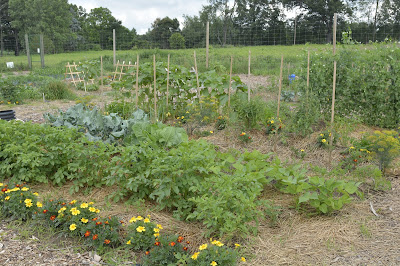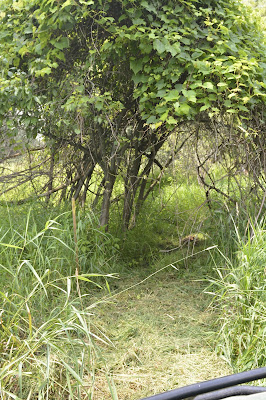As you know, every Tuesday morning we lead a nature hike, usually at Dahlem, but occasionally somewhere else. On this particular morning (June 23), the walk was at Dahlem and was led by Don and Robin Henise, volunteers and good friends of Dahlem. Their specialty is things with wings: birds, butterflies and dragonflies. This morning we were headed out specifically to look for dragon- and butterflies. We were not to be disappointed.
Right off the bat, we encountered this little woodland flutterby - it's one of the hairstreaks, possibly banded.

Thanks to all the heavy rains we'd had, the water was way up in Crouch Creek!
A good destination for dragonflies is the Reflection Pond, where one can stand on the boardwalk, without getting one's feet wet, and watch for dragonflies, damselfies, frogs and turtles. We saw several green darners, some twelve-spotted skimmers, forktail damselflies, and many dot-tailed whitefaces.
forktail damselfy
mating dragonflies
Dot-tail whiteface dragonfly
green frog
Another great place to look for dragonflies is out in the fields/grasslands. The day we went, the spiderwort was about at peak for blooming. There was a lovely purple haze across the southern end of the grasslands.
Spiderwort is mostly purple, but sometimes you find white or even magenta blossoms.
Because our group is made up of general natural enthusiasts, they also did some bird watching.

We couldn't have asked for a more glorious morning to be out in the grasslands!
Meadowhawks were plentiful in the grasslands.
One of my favorites is the ebony jewelwing, a beautiful damselfly that we quite often seen in sunny patches in the woods. I was thrilled to capture this image of one peeking over the edge of a leaf at me.
As our group made its way back to the visitor center, we encountered some artists who were out memorializing parts of our trails on canvas. It is always such a joy to see the diverse array of visitors we get out here at Dahlem.
Anyone can join us for our Tuesday Morning Walks! We meet at 9:00 AM and are usually done between 11:00 and 11:30, after which the group usually heads out to have lunch together. It's a wonderful social time for all.


















































